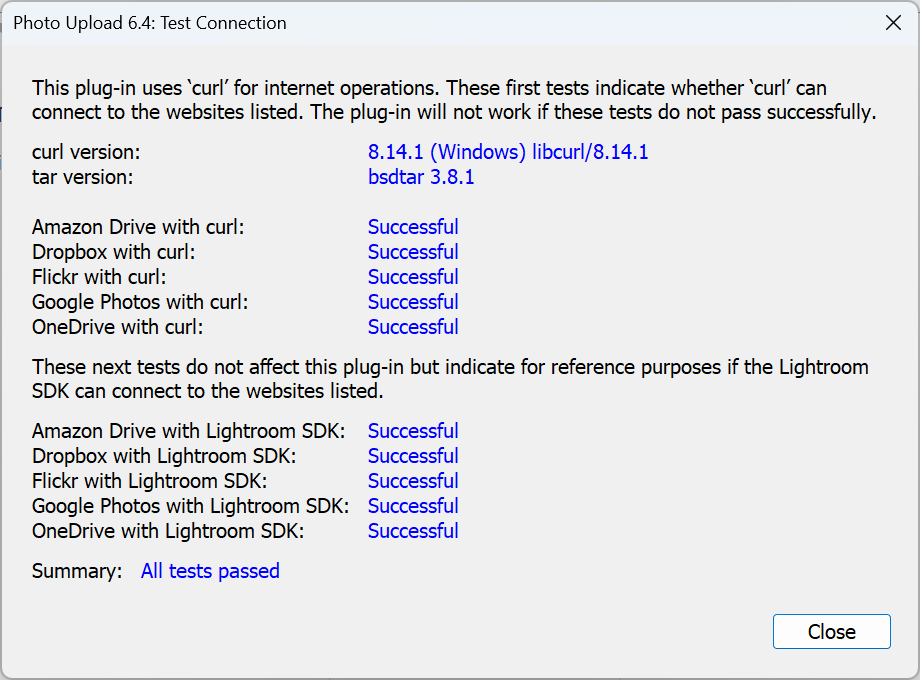Export/Publish Settings window
When Exporting you can open the Settings window by clicking the Settings button in the Export window.
Note: You can also open the Settings window from the Album Selection window during the Export but note that your settings are not stored for future Exports if you change them at this time.
When Publishing you can open the Settings window by choosing Edit Settings… from your publish service’s right click menu.
The Settings window has different options depending on the upload service you are using, but looks something like this:
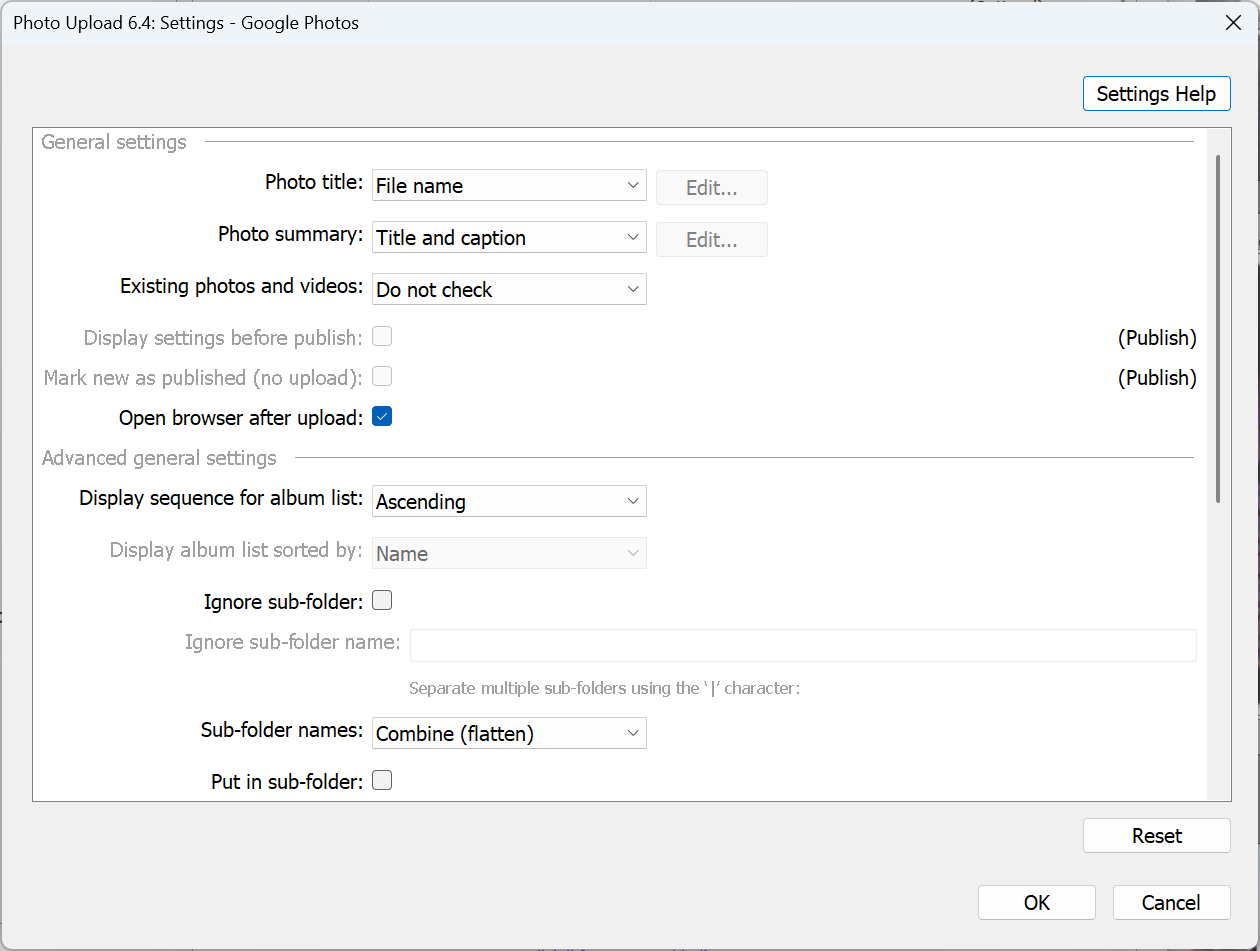
Settings documentation
Simply hold the mouse over the setting label (when it is enabled, i.e. not greyed out) and you’ll see notes about what the setting does and any specifics about using it.
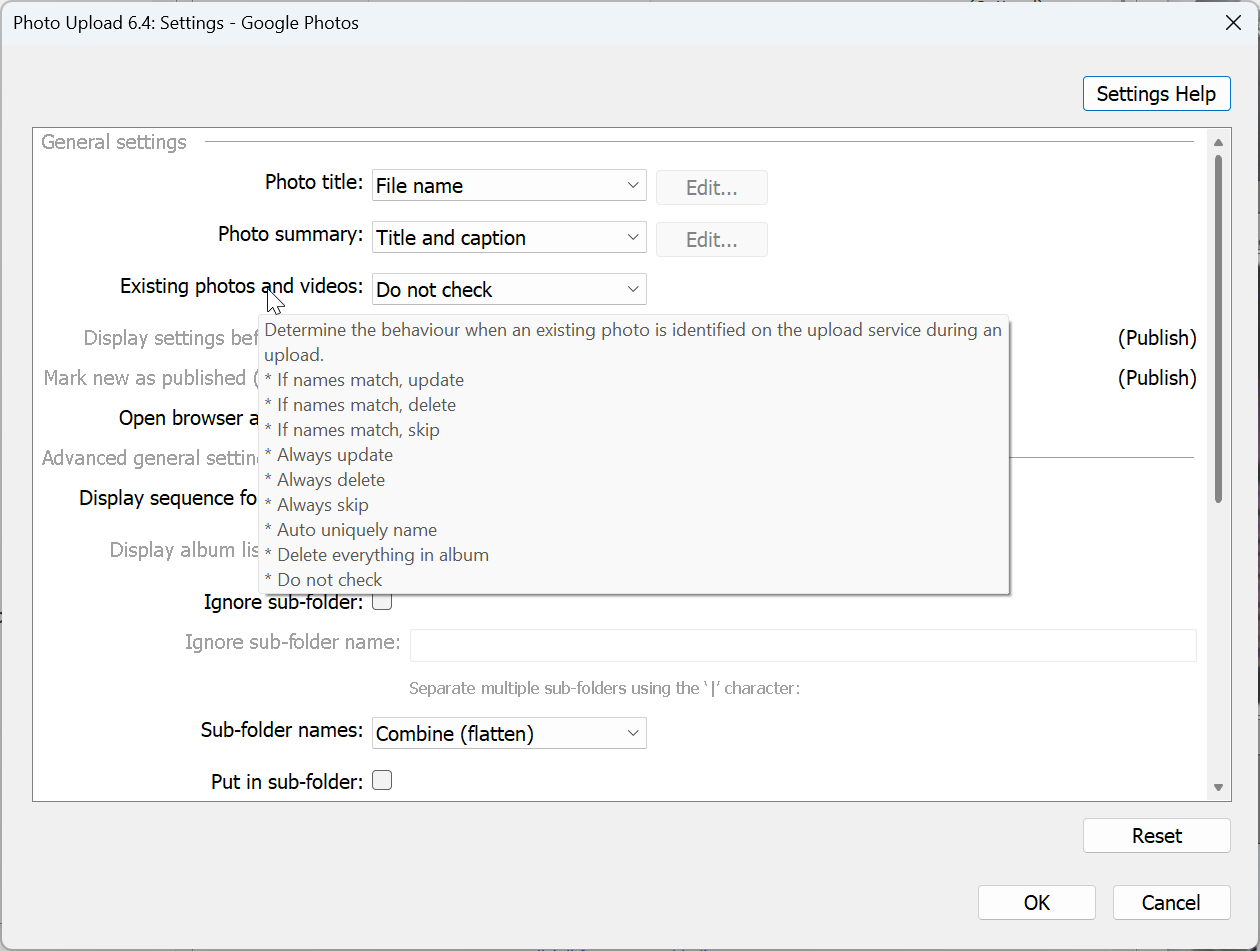
Overriding settings per photo
The plug-in settings are applied to each photo that is uploaded. You can additionally choose to override these settings for a specific photo by specifying an alternative value using Lightroom’s metadata settings for the photo. See this guide – Uploading photos – Overriding plug-in settings per photo.
Custom Text window
Some settings, such as “Photo title” and “Photo summary” allow you to use the Custom Text window to define a template for the text.
Simply hold the mouse over the label and you’ll see notes about how you can specify the custom text.
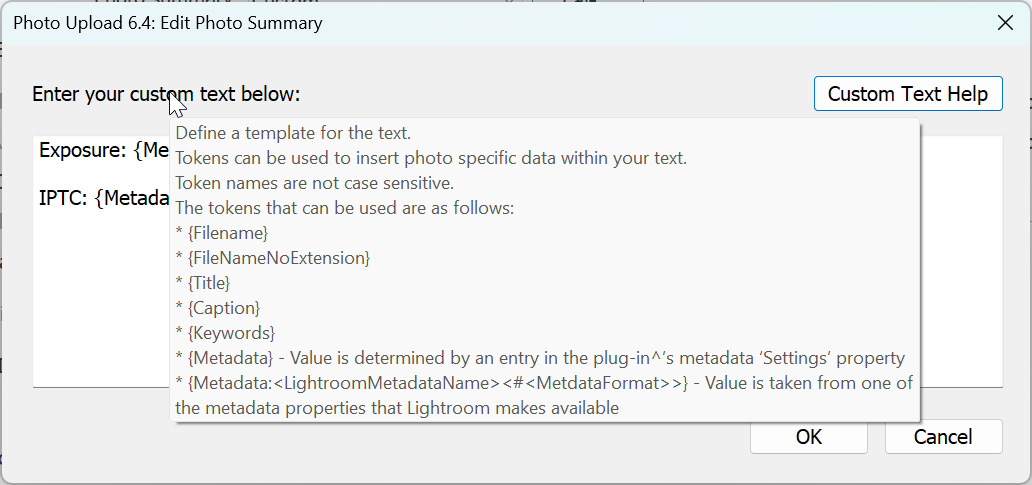
For example, if you wanted some text describing the title and caption with two new lines in between then you would enter:
{Title}
{Caption}
If you wanted to include some photo metadata you could use:
Exposure: {Metadata:exposure}
IPTC: {Metadata:iptcCategory}
If you wanted to use a different value if one value was blank then you can use the “I” character to indicate the alternative(s):
{Metadata:copyName|Filename}
{Metadata:copyName|Caption|"No copy name or caption!"}
Available metadata
You can use one of these values for the <LightroomMetadataName>.
Image metadata
Lightroom 1.3+
- keywordTags
- keywordTagsForExport
- fileName
- preservedFileName
- copyName
- folderName
- fileSize
- fileType
- rating
- label
- title
- caption
- dimensions
- croppedDimensions
- exposure
- shutterSpeed
- aperture
- brightnessValue
- exposureBias
- flash
- exposureProgram
- meteringMode
- isoSpeedRating
- focalLength
- focalLength35mm
- lens
- subjectDistance
- dateTimeOriginal
- dateTimeDigitized
- dateTime
- cameraMake
- cameraModel
- cameraSerialNumber
- artist
- software
- gps
- gpsAltitude
- creator
- creatorJobTitle
- creatorAddress
- creatorCity
- creatorStateProvince
- creatorPostalCode
- creatorCountry
- creatorPhone
- creatorEmail
- creatorUrl
- headline
- iptcSubjectCode
- descriptionWriter
- iptcCategory
- iptcOtherCategories
- dateCreated
- intellectualGenre
- scene
- location
- city
- stateProvince
- country
- isoCountryCode
- jobIdentifier
- instructions
- provider
- source
- copyright
- copyrightState
- rightsUsageTerms
- copyrightInfoUrl
Lightroom 3.0+
- personShown
- locationCreated
- locationShown
- nameOfOrgShown
- codeOfOrgShown
- event
- artworksShown
- additionalModelInfo
- modelAge
- minorModelAge
- modelReleaseStatus
- modelReleaseID
- imageSupplier
- imageSupplierImageId
- registryId
- maxAvailWidth
- maxAvailHeight
- sourceType
- imageCreator
- copyrightOwner
- licensor
- propertyReleaseID
- propertyReleaseStatus
- digImageGUID
- plusVersion
Lightroom 6.0+
- gpsImgDirection
Lightroom 13.2+
- altTextAccessibility
- extDescrAccessibility
Video metadata
Lightroom 3.0+
- duration
- trimmedDuration
- frameRate
Metadata format
The date metadata (i.e. dateTimeOriginal, dateTimeDigitized, dateTime and lastEditTime) can all be modified to return the date in a specified format.
- %B: Full name of month
- %b: 3-letter name of month
- %m: 2-digit month number
- %d: Day number with leading zero
- %e: Day number without leading zero
- %j: Julian day of the year with leading zero
- %a: Day name abbreviation
- %A: Day name
- %y: 2-digit year number
- %Y: 4-digit year number
- %H: Hour with leading zero (24-hour clock)
- %1H: Hour without leading zero (24-hour clock)
- %I: Hour with leading zero (12-hour clock)
- %1I: Hour without leading zero (12-hour clock)
- %M: Minute with leading zero
- %S: Second with leading zero
- %p: AM/PM designation
- %P: AM/PM designation, same as %p, but causes white space trimming to be applied as the last formatting step
- %%: % symbol
For example, to return just the year that the photo was taken you could use “%Y” to get the 4 digit year and if a date was not specified you could use “Unknown year”.
{Metadata:dateTimeOriginal#%Y|"Unknown year"}
Create/edit publish service collection/collection set window
When creating or editing a collection or collection set within a publish service the following settings may be available depending on the upload service selected.
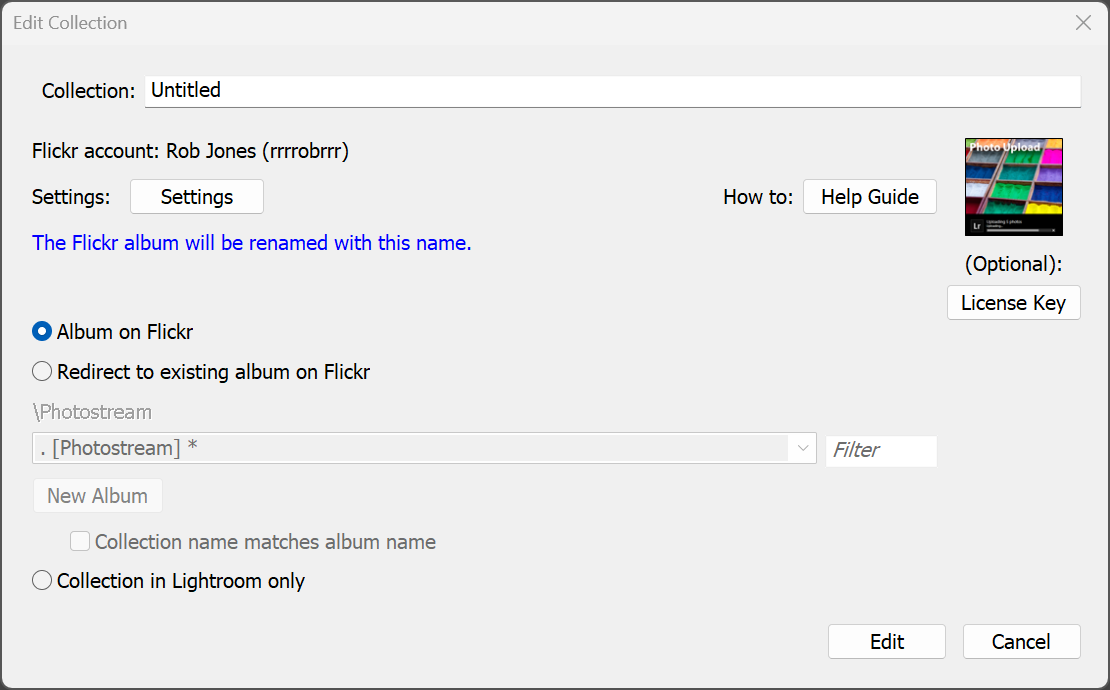
Album on <upload service>
The album/folder is created on the upload service.
Redirect to existing album on <upload service>
Specifies that this collection/collection set is redirected (i.e. linked) to an album/folder on the upload service. Any photos published from a collection with this setting will be uploaded to the redirected album on the upload service. You can name the collection in Lightroom differently to the album on your upload service.
This setting also allows you to create published collections that upload to the root folder on an upload service (if applicable to that upload service).
Collection name matches album name
This setting sets the collection name to be the same as the selected album name on the upload service.
Collection in Lightroom only
An album/folder is not created on the upload service. The collection only exists within Lightroom.
When the upload service does not directly support creating albums, all collections and collection sets have this setting selected, e.g., for X or WordPress.
Configuration window
When creating or editing an album or folder within a publish service the following settings may be available depending on the upload service selected.
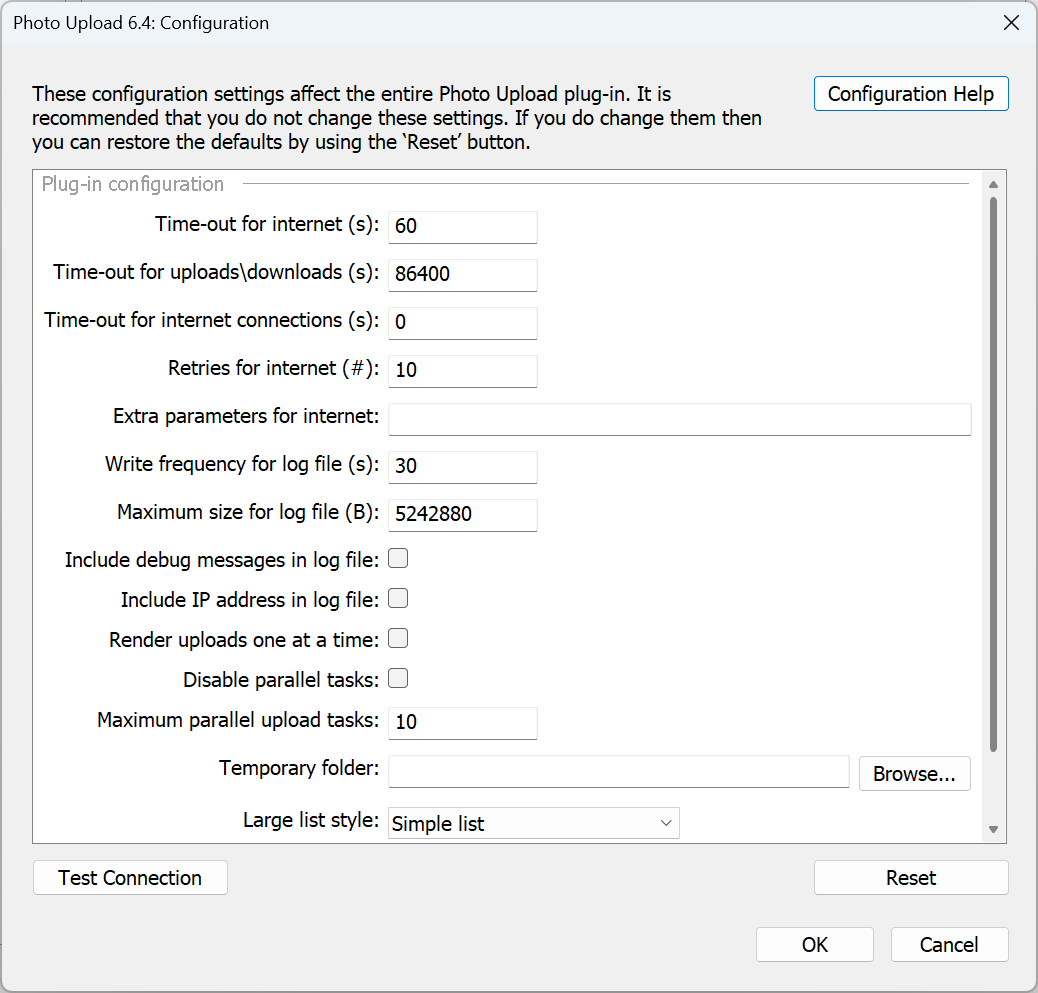
Configuration documentation
Simply hold the mouse over the configuration setting label and you’ll see notes about what the setting does and any specifics about using it.
Test Connection window
The Test Connection button opens the Test Connection window which attempts to verify your internet connection by communicating with a representative list of mainstream websites.
If the Test Connection window cannot connect with a site then this is reported.
